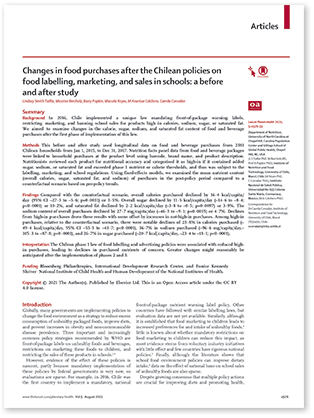The latest evaluation of Chile’s Law of Food Labeling and Advertising finds that under Phase 1 of the law’s implementation, Chileans purchased significantly fewer calories, sugar, saturated fat, and sodium than would have been expected had the law and its regulations not gone into effect.
The study, published in the August issue of The Lancet Planetary Health, combined data on household food shopping from 2015–2017 (during Phase 1 of the law) with nutrition facts data for all the products purchased to examine changes in what groceries Chileans bought before/after the law took effect.
Overall, purchased calories, sugar, saturated fat, and sodium declined significantly. Among “high-in” purchases (junk foods and sugary drinks that did not meet Phase 1 nutrition criteria), households bought 24% less calories, 27% less sugar, 16% less saturated fat, and 37% less sodium compared to what they were expected to buy, had the law not come into effect.

This evaluation builds on and confirms findings from the Global Food Research Program’s previous evaluation of changes in beverage purchases during Phase 1. In that study, authors observed a 24% drop in the volume of sugary drinks purchased and a 28% decline in calories purchased from sugary drinks, compared to expected purchases had the law not taken effect.
These results highlight the potential for multi-component policies to significantly impact people’s shopping and consumption habits. The GFRP team will continue working with colleagues in Chile and Mexico to evaluate changes following implementation of Phases 2 and 3 of the law, which have increasingly strict nutrition standards.
Read more about this research and its implications, according to the study authors.
Funding for this study was provided by Bloomberg Philanthropies, the International Development Research Center, and the Carolina Population Center (P2C HD050924).
Quick look: Chile’s Law of Food Labeling and Advertising
In 2016, Chile implemented a set of policies to improve the country’s diet and health. The law identifies junk foods using certain nutritional criteria. Any packaged foods or drinks that fail to meet those criteria are subject to:
![]() Mandatory front-of-package warning labels;
Mandatory front-of-package warning labels;
![]() Restrictions on marketing to kids (e.g., product may not be advertised on TV from 6 am–10pm, can’t use child-appealing creative techniques in marketing, etc.); and
Restrictions on marketing to kids (e.g., product may not be advertised on TV from 6 am–10pm, can’t use child-appealing creative techniques in marketing, etc.); and
![]() Banned sales or promotions in schools
Banned sales or promotions in schools
Read more of evaluations of Chile’s law:
Impacts on consumer behavior:
- Taillie LS, Reyes M, Colchero MA, Popkin BM, Corvalán C. (2020). An evaluation of Chile’s Law of Food Labeling and Advertising on sugar-sweetened beverage purchases from 2015 to 2017: A before-and-after study. PLOS Med 17(2): e1003015. view full text
- Caro JC, Valizadeh P, Correa A, Silva A, Ng SW. Combined fiscal policies to promote healthier diets: Effects on purchases and consumer welfare. PLOS One. 2020 Jan 15;15(1):e0226731. doi: 10.1371/journal.pone.0226731. eCollection 2020. view full text
Impacts on employment:
- Paraje G, Colchero A, Wlasiuk JM, Sota AM, Popkin BM. The effects of the Chilean food policy package on aggregate employment and real wages. Food Policy. 2021 Apr 1;100:102016. view full text
Impacts on marketing:
- Jensen ML, Carpentier FR, Adair L, Corvalán C, Popkin BM, Taillie LS. TV advertising and dietary intake in adolescents: a pre-and post-study of Chile’s Food Marketing Policy. International Journal of Behavioral Nutrition and Physical Activity. 2021 Dec;18(1):1-1. view full text
- Jensen ML, Carpentier FD, Adair L, Corvalán C, Popkin BM, Taillie LS. Examining Chile’s unique food marketing policy: TV advertising and dietary intake in preschool children, a pre‐and post‐policy study. Pediatric Obesity. 2021 Apr;16(4):e12735. view full text
- Correa T, Reyes M, Taillie LS, Corvalán C, Dillman Carpentier FR. Food advertising on television before and after a national unhealthy food marketing regulation in Chile, 2016–2017. American Journal of Public Health. 2020 Jul;110(7):1054-9. view full text
- Dillman Carpentier FR, Correa T, Reyes M, Taillie LS. Evaluating the impact of Chile’s marketing regulation of unhealthy foods and beverages: Pre-school and adolescent children’s changes in exposure to food advertising on television. Public Health Nutrition. 2020 Mar;23(4):747. view full text
- Correa T, Reyes M, Smith Taillie LP, Dillman Carpentier FR. The prevalence and audience reach of food and beverage advertising on Chilean television according to marketing tactics and nutritional quality of products. Public Health Nutr. 2019 Apr;22(6):1113-1124. view full text
Impacts on social norms:
- Correa T, Fierro C, Reyes M, Carpentier FRD, Taillie LS, and Corvalan C. (2019). Responses to the Chilean Law of Food Labeling and Advertising: Exploring knowledge, perceptions and behaviors of mothers of young children. International Journal of Behavioral Nutrition and Physical Activity 16(1): 21. view full text
